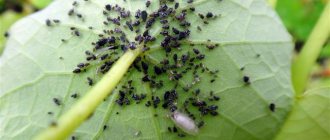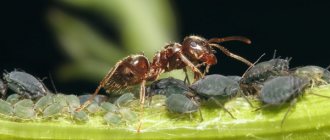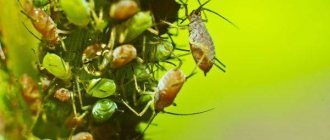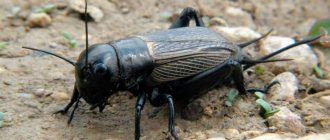If you notice gnawed stems of seedlings or eaten leaves, it means you have crickets in your garden. Let's look at how to get rid of them in detail. Around the beginning of April, at the dacha, as soon as evening comes, there are crickets. The chirping of crickets is directly associated with summer, but all the romance ends there, since in addition to the “songs” they cause significant damage to garden plantings. These insects have a good appetite and happily feed on all vegetables and cereals.
Black cricket close-up photo:
Crickets, for those who are not familiar with them, look like black grasshoppers in the garden, jumping just as briskly. Crickets in the garden, what harm do they do? These insects are omnivores; they cause the same damage to strawberry bushes, potatoes, corn, legumes, and other plants.
The harmfulness consists of damage to the root collar of the stem or the small plant being eaten entirely. On the fruits of raspberries and strawberries you can see chewed pulp.
Spraying the garden with chemicals is not always advisable, since the berries or vegetables will subsequently be eaten. If you follow certain rules, you can still use chemicals, but today there is a worthy bio-alternative.
What do crickets eat in the garden? The answer is everyone! In addition to their plant diet, these insects do not disdain their relatives, their larvae, worms, and dead animals. Even their own clutches of eggs, as well as young representatives of their species, can become “dinner” for adult insects.
An adult reaches a length of 1.5-2 cm and has a black body color. The black cricket (field) is the most common species of the cricket family.
Field cricket:
Field (black) cricket, photo
Varieties and botanical description
There are 4 types of crickets: house, field, stem and ant. Let's take a closer look at them.
Brownie
The house cricket has a gray-yellow color with brown streaks, and has 3 stripes of the same color on its head. Individuals measure up to 25mm. They have a chitinous layer that protects it from moisture loss and some environmental influences.
The antennae of these insects perform the function of touch, the two front pairs of limbs are responsible for hearing, and the two rear ones are responsible for moving by jumping.
Interesting to know: some beliefs say that a cricket in the house brings good luck and protects against disease and evil.
But if there are too many insects, this will lead to great harm to cultivated plants.
Field
Basically, these crickets live in meadows and fields, but can also be found in pine forests. They live in the ground at a depth of about 20 cm.
They have dimensions close to the size of a brownie, but have a black color with a glossy tint. You can find brown individuals with orange splashes. They also have antennae and eyes.
Stem
This type of cricket has another name: “eastern trumpeter”. This species is smaller in size than its family. Their size is only about 1.3 cm, the color of the stem cricket is green, with a black stripe on the belly.
This species got its name because it lays eggs in plant stems. Each clutch contains no more than 2-3 eggs. In mid-summer, larvae emerge from the eggs, which then turn into adults.
Formic
Ant crickets are small in size even compared to their relatives. They grow to only 5 mm, have no wings, and look like cockroaches. This species cannot make sounds.
They nest next to ants and spend the winter in anthills. Their larval development cycle from egg laying is about 2 years and is divided into five stages.
Who are crickets and where do they come from in the house?
The cricket belongs to insects from the Orthoptera family (genus crickets), its homeland is northern Africa and the Far East. These insects, of which there are about 40 species in our country, are divided into field and domestic. Naturally, house crickets, whose chirping often disturbs sleep, cause concern.
If wild crickets dig a hole for themselves, reaching a length of up to 30 cm, then domestic ones prefer to live in warm and dark places, mainly near heating devices. The insect is nocturnal and can only be heard at night. Only males can chirp.
Cricket fighting is especially popular in Asian countries.
Often the reasons why crickets are brought into a home are heat (temperature from 20 ° C) and high humidity. Without these conditions, insects become inactive, lose their ability to reproduce, and stop feeding. And also the development and growth of larvae stops.
Crickets appear in the house from boiler rooms and basements, easily penetrating through ventilation grilles, cracks in doors and windows. For laying, crickets choose the space behind the tiles, cracks in the plaster, the underside of old wallpaper, books, the back wall of furniture, cracks between the baseboard and the floor, and ventilation ducts. Adults live under the sink, near heating appliances in dark places, etc.
Do not create conditions for the appearance of crickets: do not overdo it with heating devices
House crickets feed on:
- food of plant origin;
- cockroaches;
- leftovers from the table;
- other invertebrates;
- own clutch and young larvae.
If there is only one cricket, then its appearance, as a rule, does not threaten anything. But with his songs he can attract females, and then their number and noise will increase.
During the nesting and breeding stages, crickets damage paper products, furniture, walls and even clothing
. As in nature, they dig holes for eggs. Only they do this not in the ground, but in things, gnawing holes in book sheets, sofas, etc.
Life cycle, reproduction of an insect
Crickets become sexually mature a month after hatching. These insects are able to reproduce in warm weather. Their development occurs in the following stages:
- egg;
- larva;
- adult insect.
Females lay eggs in places hidden from unwanted eyes. This can be soil, earth, or eggs can also be found under stones. They are small in size and yellowish in color. Temperature plays a big role in how many eggs a female lays. If it changes dramatically, there will be fewer eggs. Insects consume plant food, fruits, vegetables, berries, bran, bread, fish food, meat or even fish.
Is the cabbage butterfly a pest or not?
Inexperienced gardeners are often perplexed as to why so many white butterflies appear on raspberries. Are they pollinators, or are they dangerous pests that can destroy a large percentage of the crop? A simple-looking butterfly actually helps pollinate raspberry bushes, but at the same time the insect lays larvae. This is where the main danger lies.
Females lay orange eggs on the reverse side of the leaf. The larvae hatch from them and actively devour leaf tissue, buds and flowers. If you start the process, the caterpillars will make holes in the entire green mass. Because of this, the raspberry bush weakens; it no longer has enough strength to grow full-fledged berries.
Raspberry pests that gnaw leaves to the point of “skeleton” are the caterpillars of the hawthorn butterfly. They are very common in gardens and wildlife and are confused with another pest, cabbage grass. These two insects have differences:
- The hawthorn is a butterfly with white wings covered with thin black stripes, while the cabbage has black spots and corners on its wings.
- The larvae are also different - in hawthorn the caterpillar has noticeable pubescence.
- And one more thing: cabbage’s favorite food in the garden is the Cruciferous family (cabbage, radishes, etc.), and hawthorn eats fruit trees and shrubs (rowan, hawthorn, pear, etc.).
When can we expect hawthorn to appear?
This butterfly emerges from the pupa in May-June (the warmer the climate, the earlier). Approximately once every 4-6 years, due to natural reasons, the number of these insects increases. If a wet summer is predicted, then it is worth carrying out preventive procedures in the garden in early spring.
Where do they live and how to detect parasites?
Crickets live in damp and warm places, so it’s worth finding such a place in the garden. It is also possible that crickets have settled somewhere in the house. In places such as the bathroom and basements. Sometimes the insect can settle in the attic. If you haven’t found a suitable place to live on the street, and it still harms your garden plants, you should look for the parasite in the greenhouse, sheds and garages.
One of the ways to destroy an insect that has settled on the street is to hang up feeders, because birds eat them.
Tools Overview
When treating a room with chemicals, you should wear gloves and preferably a face mask. After finishing, thoroughly ventilate the room.
Effective pest control products:
- Doctor Klaus. An effective universal insect repellent. The product is produced in the form of a spray. It must be sprayed directly on the pest or on their possible habitats. The price fluctuates around 230 rubles.
- Dichlorvos is universal. A universal remedy for different types of insects. Has no smell. But after use, the room must be ventilated. It is not advisable to be in the room without a mask. Cost from 75 rub.
- Tornado. Destroys harmful parasites such as crickets, spiders, and Prussians. Produced in the form of a spray in a volume of 100 ml. Cost from 90 rub.
- Raid. He will cope with any task given. Kills all small insects. Raid is a spray can. Convenient indoor use for hard-to-reach places. After use, ventilate the room. The cost ranges from 120 rubles.
- Tarax. It can be used indoors and outdoors. The drug helps fight crickets and other insects. Cost from 120 rub.
Pest control: drugs and methods
To create unfavorable conditions for crickets, a dry house is enough. But if it does appear, you can treat the house with a special product, for example, Dichlorvos. If you need chemical treatment in your home, you should leave it to avoid poisoning.
Biological protection of crops and seedlings
For biological protection of crops, those that destroy insect pests without harming plants, humans, birds and animals are suitable. Therefore, it is better to use biological agents in the garden that will definitely help get rid of black cricket.
You can use the following drugs: Nemabact and Antonem-F. They literally rid the garden of 80% of the larvae in just 4 days. And in a month all 100% will be destroyed. It is advisable to spray the soil with these preparations during the growing season. Controlling crickets in the garden using these means is the most effective and safe.
Mechanical methods
You can get rid of crickets in a greenhouse by simply digging up the area in the fall. But this may not be enough, so it is necessary to loosen the soil between the rows.
There should be no boards, building materials or fallen trees on the site, because these insects can settle there to overwinter.
Chemicals
To remove crickets from the garden, you can use chemicals such as Karbofos or Decis, which are diluted in an amount of 3-6 g per 5 liters of water or 3 ml per 10 liters of water, respectively. In addition to these drugs, you can use a garden remedy for crickets called Lindane, but this drug is incredibly toxic and can be harmful to humans.
Chemicals can be used no more than 2 times per season, and the last treatment is carried out no later than 15 days before harvest.
Traditional methods for exterminating pests
If you need to get rid of crickets using folk remedies in the garden, use one of the following methods:
Sweet trap
To prepare the trap you will need a deep plate or something like that. The container is filled with a sweet, sticky composition. You can mix sugar with water, put molasses on a plate, or pour in fruit juice. Once a cricket gets into the container to feed, it can't get out.
Vacuum cleaner
This method of catching a pest cannot be called effective, because catching this nimble insect with a vacuum cleaner is quite problematic. That is why a vacuum cleaner is used mainly to destroy parasite eggs. After collecting eggs and dead individuals, it is necessary to clean the collection container at a great distance from the house.
Plants
To scare away uninvited guests, you can use a composition of wormwood. To prepare the mixture you will need 1 liter of water and 2 tablespoons of crushed leaves. The composition must be boiled for 5-10 minutes under a closed lid, then left to cool. When the mixture has cooled, it is filtered and the floors, baseboards, window sills, etc. are treated with a sprayer. You can remove crickets using this method by spraying all crops from the garden.
Trap pit
This method is the most difficult, but also more effective. It involves catching insects with bait. To create something like a pit, you need a two-level container.
The bait will be:
- cornflakes;
- sugar;
- milk;
- vodka.
Cereals or sugar are placed on the lower tier of the container and milk is poured. You need to pour alcohol into the upper compartment. The method is based on the fact that cereal and milk will attract crickets, and alcohol vapor will rid the garden of these pests. For everything to work out, you need alcohol that contains at least 70% ethanol.
Adhesive tape
This method is the easiest one described in this article. Adhesive tape should be placed in the crickets' habitats. Perhaps this is the bathroom, window sills or baseboards. But this method takes more time than many others. It is better to put the tape on for a day.
If a person is present in the room, the cricket will most likely not fall into the trap.
Sealing wax
A fusible mixture that has a pungent odor that no insect likes. To use this method, sealing wax in the form of a candle works better. You just need to light the cinder and then go through all the rooms in the house. This product will not harm humans or animals.
What harm do they do?
Crickets are omnivorous and cause enormous damage to garden plants.
In addition to the remains of human food, worms and small insects, the bugs eat leaves and root stems of plants.
They cause the most damage:
- strawberries;
- potatoes;
- corn;
- legumes;
- tobacco;
- wheat;
- rye;
- beans;
- beets;
- carrots;
- onion;
- tomatoes;
- cabbage
In terms of damage, a cricket invasion can be compared to its closest relative, the locust. These insects can leave a gardener without any hope for a harvest in a very short time.
In Asian and African countries, crickets are bred specially. These insects are eaten (their bodies are rich in calcium and protein). They even make chips from them.
Secrets on how to get rid of a clutch of cricket eggs
To rid your garden, greenhouse or home of crickets forever, you need to make sure that there are no eggs being laid. They are found in damp, hard-to-reach places, in baseboards and basements.
To get rid of masonry, you can:
- use a vacuum cleaner;
- invite specialists;
- treat the suspected masonry sites with a special aerosol, preferably twice.
A million troubles because of a larva
What can compare with the most delicate blossoming of the first daffodils or crocuses, breaking through the snow in early spring and touchingly stretching their fragile buds towards the sun? Only the same fragile beauty in the middle of winter, when the heart yearns for the summer sun.
The most expensive gift for any holiday will be a bouquet that appears as if from a fairy tale.
And such a miracle is quite real; many people who are interested in floriculture like to surprise their friends and acquaintances by growing bulbous flowers all year round in heated greenhouses. Someone turns a hobby into a very profitable business, selling not only bouquets, but also bulbs and children, receiving several harvests throughout the year.
But flower growers never run out of worries before the birth of a miracle. One of them is the fight against the most dangerous pest - the larva of the click beetle, which can destroy almost all the bulbs of flowers planted in an infected greenhouse.
A tiny paradise under glass among the snow or slush of the off-season can delight owners and surprise guests every day and hour. And how could it be otherwise: strong stems make their way to the sun in even rows in the greenhouse, buds open in all their variety of colors and shapes.
And suddenly a picky eye notices some kind of discrepancy - against the background of general well-being, the drooping stem of one flower, fallen petals on another, wilted leaves on several more do not yet look like a disaster. But they talk about its probable beginning.
The disease and death of several plants of the same or different varieties, located quite far from each other, if the rest look completely healthy, may indicate damage to the soil by pests called wireworms.
IMPORTANT! The worms, which look like pieces of copper wire, have their own name, although they are just the larvae of one of the varieties of the beetle - the click beetle. The beetle itself is safe, but the larvae can turn a gardener’s life into hell, eating and mutilating the underground part of all plants, tubers and bulbous flowers are especially affected.. Small, 2-4 cm in length larvae, hatched from the eggs of a click beetle, in the first year invisible and almost non-threatening
Small, 2-4 cm long larvae, hatched from the eggs of the click beetle, are invisible in the first year and pose almost no danger.
In the second year of their life cycle, they become very active, voracious and acquire a yellowish color.
The hard body is difficult to crush; because of this feature and color, the beetle larva is called a wireworm.
You can learn more about this pest in a special article!
Prevention measures
To prevent crickets from appearing in the house again, you should:
- attach mosquito nets;
- treat corners and crevices near batteries to prevent larvae from hatching;
- do not leave crumbs on the kitchen table;
- Keep the room clean and dry.
To prevent crickets in your area, you need:
- use low-power lamps in courtyards;
- It is advisable to place the compost as far as possible from the living space;
- keep front gardens in order;
- Do not leave trash on the street.
All the methods described are also used in greenhouses. In open areas, it is better to use methods such as duct tape, trapping pits, plants and a sweet trap, but they are unlikely to be effective. Therefore, chemical and biological agents are usually used outdoors.
Optimal conditions for the appearance of woodlice on the site
Woodlice may choose a garden plot to colonize if it has suitable conditions for them. This may include:
- the presence of fallen trees on the site that have remained lying, and piled up boards that have already begun to rot;
- plant debris left for a long time near the beds and rags and other debris scattered throughout the garden;
- compost pit and open dump for organic waste within the site;
- excessively high humidity in the garden and inside greenhouse structures.
All this contributes to the appearance of woodlice in the garden. Most likely, they will then definitely move to the greenhouse, because it is there that is always humid, which is most optimal for their residence and active reproduction. As preventive measures in the fight against woodlice, or rather, with their appearance, the following are necessary:
- regular ventilation of the greenhouse;
- rationing of water consumption during irrigation;
- thinning the plantings to avoid thickening;
- timely removal of weeds, including from the passages between the ridges;
- loosening the soil and mandatory autumn digging.
Criterias of choice
Before you start fighting household pests, you need to decide on the choice of disinfestation method. Here the emphasis is on what type of insect is annoying in the apartment, what its number is and how long it has been parasitizing. The safety level of the insecticide should be determined and whether it has an unpleasant odor.
Human safety
All pesticides are divided into highly toxic, moderate and weak. Before using aerosols or insecticide concentrates, you should read the instructions for use of the product. The procedure for treating the premises takes place when the household members leave the apartment. Boric acid, borax, and plants with a strong odor for repelling are safer and more environmentally friendly. But care must be taken to ensure that children do not try these substances or the bitter herb.
Having an unpleasant odor
Many insect repellents have an unpleasant odor. It will make you dizzy if you stay in the house during treatment. With aerosols, the smell quickly disappears. Gels are available with a pleasant aroma or odorless. The plant smells strongly of wormwood, which is often used to repel cockroaches and fleas.
Ease of use
Carrying out pest control in an apartment yourself requires the use of products that are convenient to apply to surfaces. It is not for nothing that sprays in aerosol packages are chosen. They also give preference to ultrasonic devices, which they plug into the network and that’s it.











